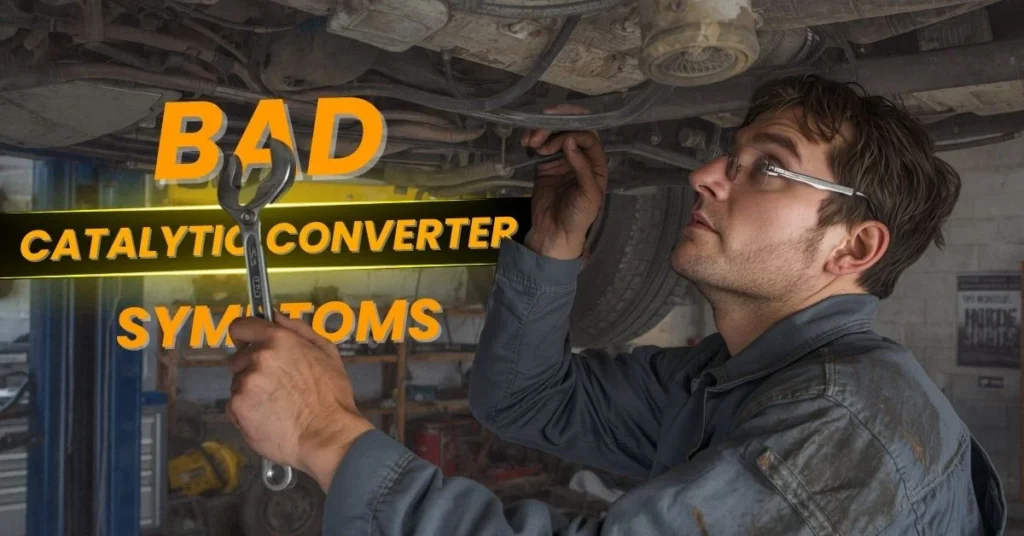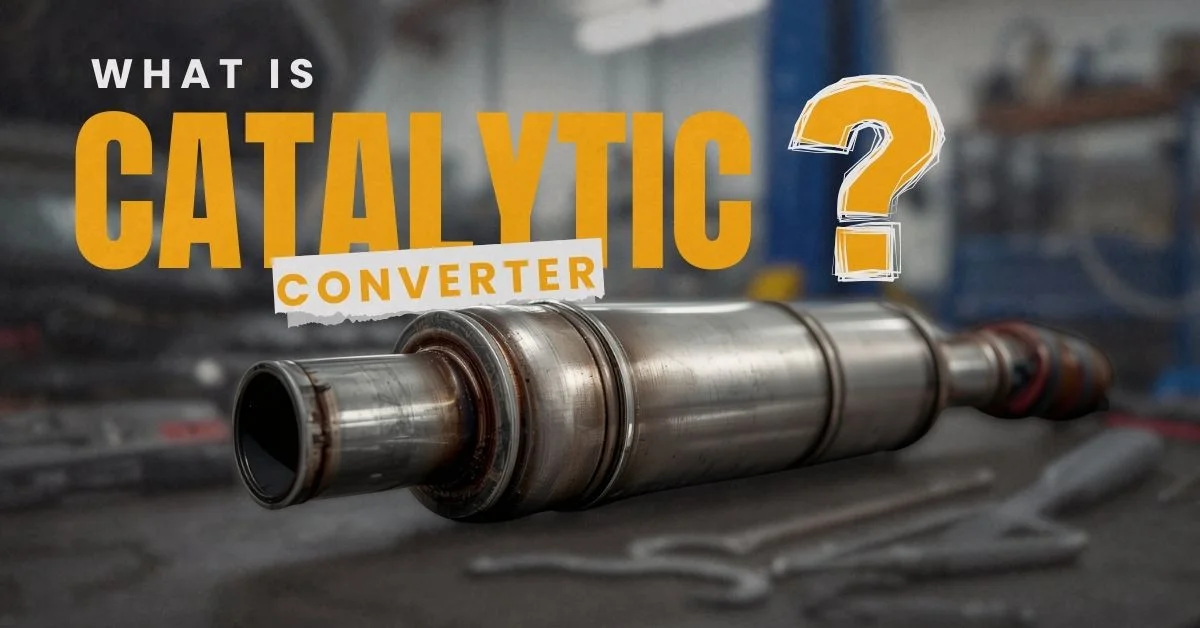Table of Contents
Your car’s exhaust system hides a tiny hero—the catalytic converter. It’s tucked away under your vehicle, but its job is anything but small. A catalytic converter changes nasty exhaust gases into cleaner ones, keeping both your engine happy and the planet a bit healthier. Because it works quietly, many drivers overlook it, but knowing how it works and when to care for it can save you big bucks down the road and keep your ride running like new.
In this easy-to-read guide, you’ll discover how catalytic converters work, how to clean them the right way, when it’s time to swap them out, what it costs, and even how much cash you can pocket if you sell an old one for scrap.
What is a Catalytic Converter?
A catalytic converter is a key pollution-control device that changes the toxic exhaust your engine produces into much less harmful gases before they finally leave the tailpipe. Think of it as your car’s environmental watchdog; it turns dangerous carbon monoxide, nitrogen oxides, and unburned hydrocarbons into benign water vapor, carbon dioxide, and nitrogen.
Positioned neatly between the engine and the muffler, the catalytic converter is the exhaust system’s last line of defense against pollution. Inside, it contains a ceramic or metallic substrate with a honeycomb structure, coated with tiny amounts of precious metals like platinum, palladium, and rhodium. These metals speed up the chemical changes that neutralize the pollutants without wearing out or changing themselves.
The catalytic converter does more than protect the planet; it also fine-tunes engine performance. By keeping exhaust gases flowing properly, it supports complete fuel combustion. When the converter is healthy, your engine runs more efficiently and stays within the strict emission limits set by the Environmental Protection Agency.
What Do Catalytic Converters Do?
Your catalytic converter functions as a sophisticated chemical factory that transforms dangerous exhaust gases into safer emissions through three critical reactions:
Carbon Monoxide (CO) Conversion: The converter oxidizes deadly carbon monoxide, combining it with oxygen to create carbon dioxide, a much less harmful substance that occurs naturally in the atmosphere.
Nitrogen Oxides (NOx) Reduction: High combustion temperatures create nitrogen oxides that contribute to smog formation. The converter breaks these compounds down into harmless nitrogen and oxygen molecules.
Hydrocarbon Oxidation: Unburned fuel molecules escape your engine as hydrocarbons. The catalytic converter oxidizes these molecules, converting them into water vapor and carbon dioxide.
The catalytic converter operates in tandem with upstream and downstream oxygen sensors. The upstream unit reads the mix of air and fuel as it leaves the engine, while the downstream sensor checks how effectively the converter is working. Together, these sensors form a closed loop that constantly fine-tunes both the combustion process and the removal of harmful emissions.
Bad Catalytic Converter Symptoms

Recognizing warning signs of a failing catalytic can save you from expensive repairs and help you avoid being stranded. Here are the most common symptoms:
| Symptom | Description | Possible Impact |
| Check engine light | Triggered when oxygen sensors detect abnormal exhaust composition or converter inefficiency | Failed emissions test, potential fines, inability to register vehicle |
| Reduced performance | Noticeable loss of acceleration power, especially during highway merging or hill climbing | Increased fuel consumption, dangerous situations when merging into traffic |
| Rattling noise | Metallic rattling from underneath the vehicle, caused by broken internal honeycomb structure | Progressive internal damage leading to complete blockage |
| Failed emissions test | Vehicle produces excessive levels of harmful gases during state testing | Legal prohibition from driving, inability to renew registration |
These symptoms typically progress through distinct stages, from subtle performance changes to complete failure. Early detection prevents secondary damage to other expensive components and ensures you maintain legal operation status.
Catalytic Converter Cleaner – Does It Work?
When your check engine light starts flashing, you might wonder if a $15 bottle of catalytic cleaner can save you from a $1,500 replacement bill. The answer depends on the type and extent of the problem.
How Catalytic Cleaner Formulations Operate: Many of these formulations combine surfactants, low volatility hydrocarbon solvents, and mild combustion catalysts that sequentially solubilize carbonaceous deposits, exhaust soot, and residual lubricants clinging to the catalyst’s platinum, palladium, and rhodium surfaces. The operator typically cycles the treatment through the exhaust stream over three to six tank fills; the surfactants and solvents slowly penetrate the foulants and lithium- or cerium-based combustion promoters enhance in situ oxidation, returning the catalyst to diagnostic readiness and improving exhaust flow.
Most Effective Market Formulations: The benchmark products are Cataclean, which is EPA-certified and receives broad endorsement from service advisers; Chevron Techron Concentrate Plus, recommended primarily for preventative maintenance and occasional light duty; and Sea Foam Motor Treatment, which is compatible with both modern and legacy fuel systems.
Optimal Timing for Application: These formulations are maximally beneficial after minor throttle hesitation, slight exhaust puffing of grey smoke, or initial catalyst efficiency codes, typically the P0420 family. They are also effective on light to moderate deposits from advanced ignition timing, minor oil ingestion, or infrequent fuel quality lapses that trigger short-term, reversible trim anomalies.
When the Cleaner Can No Longer Help: Any structural degradation—whether fractured substrate walls, fully occluded passages that create dangerous differential pressure, thermal cycling embrittlement, or oxidation shrinkage in units exceeding 150,000 miles—exceeds the remedial scope of any liquid additive.
Perspective Caution: These chemicals penetrate only to the first 40 to 50 microns of the substrate’s active face; they dissolve ash and soot aggregates but cannot reconstitute substrate geometry or synthesis-precipitated platinum reserves, nor will they rectify compromise from mechanical or thermal shock events.
Catalytic Converter Replacement
When to Replace a Catalytic Converter
Replacement becomes necessary when you experience:
- Severe clogging that causes significant backpressure and power loss
- Physical damage including cracked housings or broken internal structures
- Failed emissions testing with no other identifiable cause after cleaning attempts
Professional diagnosis can determine whether your specific situation requires cleaning or replacement, preventing wasted money on ineffective treatments.
Catalytic Converter Replacement Cost
Replacement costs vary significantly based on vehicle type and converter specifications:
| Vehicle Type | Parts Cost | Labor Cost | Total Cost |
| Economy Car | $200–$600 | $70–$150 | $270–$750 |
| Mid-range Sedan | $300–$900 | $80–$200 | $380–$1,100 |
| Luxury/Sports Car | $700–$2,500 | $150–$400 | $850–$2,900 |
OEM parts cost more than aftermarket alternatives but offer guaranteed compatibility and longer warranties. Labor costs depend on converter location and accessibility, with some requiring exhaust system removal.
Catalytic Converter Price & Scrap Value
New catalytic converter prices range from $200 for basic aftermarket units to $2,500 for luxury vehicle OEM parts. The significant price variation reflects differences in precious metal content and manufacturing standards.
Catalytic converters maintain substantial scrap value due to their precious metal content:
| Metal | Average Market Price (per gram) |
| Platinum | $30–$35 |
| Palladium | $60–$65 |
| Rhodium | $400–$500 |
This high scrap value unfortunately makes catalytic converters attractive targets for thieves. A stolen converter can yield $50–$500 in scrap value, explaining the rising theft rates in many areas.
High Flow Catalytic Converter
High-flow catalytic converters are engineered for performance-oriented automobiles desiring incremental horsepower enhancements without the total forfeiture of emissions mitigation. These components incorporate optimized internal geometries that facilitate elevated exhaust gas passage while sustaining fundamental catalytic oxidation and reduction processes.
Practitioners recognize the following salient attributes:
- Performance Orientation: calibration minimizes backpressure and consequently amplifies volumetric efficiency, empowering the engine to deliver enhanced power curves.
- Enhanced Permitivity: elevated cell densities and tailored substrate geometries yield improved gas permeability when compared to conventional devices.
- Applicability to Competition: these units are predominantly deployed in track-only or dedicated off-road contexts can regard thermal and mechanical performance over absolute pollutants reduction.
- Regulatory Implications: their construction may not comply with state or federal vehicular emissions statutes across all jurisdictions.
Empirical testing of representative products corroborates that 5 to 15-horsepower incremental increases can occur concurrent with residual catalytic treatment of certain pollutants; such performance metrics render these converters attractive to owners of extensively modulated racing or street vehicles.
Conclusion
Understanding what catalytic converters do and maintaining them properly protects your investment while ensuring legal, environmentally responsible vehicle operation. Whether you’re dealing with early symptoms or planning preventive maintenance, this guide provides the knowledge needed to make informed decisions about your vehicle’s emissions control system.
Frequently Asked Questions
How long do catalytic converters last?
Most catalytic converters last 80,000 to 100,000 miles under normal driving conditions. Factors like engine misfires, contaminated fuel, or excessive heat can cause premature failure.
Can a bad catalytic converter ruin my engine?
Yes, a severely clogged catalytic converter creates backpressure that can damage your engine. Symptoms include overheating, reduced power, and potential internal engine damage if left untreated.
Is catalytic converter cleaner safe for my car?
Quality cleaners from reputable brands are safe when used according to directions. They’re formulated to work with modern fuel systems and won’t damage oxygen sensors or other components.
Why are catalytic converters stolen?
Catalytic converters contain valuable precious metals (platinum, palladium, rhodium) that can be quickly extracted and sold to scrap dealers. They’re easily accessible under most vehicles and can be removed in minutes.
How do I know if I have a high flow catalytic converter?
High flow converters typically have different part numbers, modified external appearance, or performance-oriented markings. Your vehicle’s performance characteristics and exhaust sound may also differ from stock configurations.


Your blog is a treasure trove of valuable insights and thought-provoking commentary. Your dedication to your craft is evident in every word you write. Keep up the fantastic work!
Your blog is a constant source of inspiration for me. Your passion for your subject matter shines through in every post, and it’s clear that you genuinely care about making a positive impact on your readers.